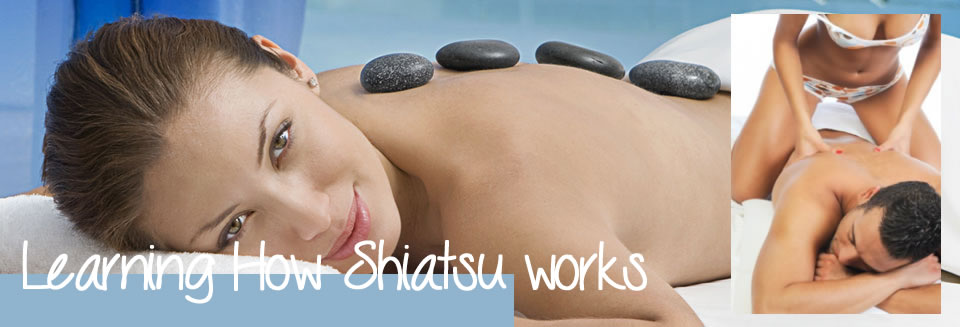Learn Shiatsu
Learning How Shiatsu can work for you
Bring in the new year - Learn Shiatsu's Introduction to shiatsu contains very important pointers that will help you learn the art of Shiatsu effectively; it also presents some important 'do's and don'ts' to consider when giving a Shiatsu treatment.
See commonly asked questions about Yoga
Therefore it is strongly recommended that you read it carefully before proceeding to Part One.
- Yin and Yang
- THE ABDOMEN TREATMENT
- Leg Pressure Points
- Preparing for a Shiatsu Session
- The Five Elements
- Shoulder pressure points
- THE STEP-BY-STEP SEQUENCE
- RESOURCES
- The origins of Shiatsu
- Techniques
- How to find the points
- POINTS TO REMEMBER
- How much pressure to use
- SELF-SHIATSU
- Choosing a school or practitioner
- SELF-TREATMENT
- Shoulders Treatment
- Vital organs
- Energy channels
- TREATING THE INDIVIDUAL
- DEVELOPING YOUR TECHNIQUE
- Energy in the hands
- Hara and breathing
- SELF-DEVELOPMENT EXERCISES
- Back of body treatment
- Front of leg pressure points
- Toe Treatment
- Tsubos
- Kyo and Jitsu
- Increasing your sensitivity
- Governing Vessel
- Forehead Massage

Other sites to look at
| capital-spas.co.uk |
| katyperrybeauty.co.uk |
The origins of Shiatsu
Shiatsu comes to us primarily from Japan. It is generally considered to have two main roots, both of which still fundamentally influence Shiatsu as it is practised and taught today. One source is the ancient and profound system of classical Chinese medicine, which was imported into Japan over many centuries, while the other forms a more traditional, folk-medicine approach to massage, itself a descendent of the instinctive art of healing by touch, which was handed down within families and communities in the Far East.
This fusion of influences may account for the effectiveness of Shiatsu, not only as a highly sophisticated clinical therapy, but also as a simple, natural, intuitive, personal and very physical activity, well suited to a domestic situation. It is probably also why those who are relatively new to the practice of Shiatsu are able to bring benefit to those they work on, using very simple techniques they have just acquired.
Last century, Western understanding of anatomy and physiology began to gain admiration in Japan, also influencing the development of Shiatsu. Finally, the last fifteen years or so have seen a phenomenal growth in awareness and popularity for Shiatsu beyond the Orient, and particularly in Europe, the USA and Australia. Consequently, Shiatsu technique is naturally evolving in the West, in forms that are appropriate to deal with modern Western lifestyle and health issues.
The origins of Shiatsu
Shiatsu comes to us primarily from Japan. It is generally considered to have two main roots, both of which still fundamentally influence Shiatsu as it is practised and taught today. One source is the ancient and profound system of classical Chinese medicine, which was imported into Japan over many centuries, while the other forms a more traditional, folk-medicine approach to massage, itself a descendent of the instinctive art of healing by touch, which was handed down within families and communities in the Far East.
This fusion of influences may account for the effectiveness of Shiatsu, not only as a highly sophisticated clinical therapy, but also as a simple, natural, intuitive, personal and very physical activity, well suited to a domestic situation. It is probably also why those who are relatively new to the practice of Shiatsu are able to bring benefit to those they work on, using very simple techniques they have just acquired.
Last century, Western understanding of anatomy and physiology began to gain admiration in Japan, also influencing the development of Shiatsu. Finally, the last fifteen years or so have seen a phenomenal growth in awareness and popularity for Shiatsu beyond the Orient, and particularly in Europe, the USA and Australia. Consequently, Shiatsu technique is naturally evolving in the West, in forms that are appropriate to deal with modern Western lifestyle and health issues.
Prices and Tuition
£50 for "First Session" Pilates or Pilates/Yoga or Yoga session, 1 1/2 -2 hours (where a consultation is involved). The first Pilates only or mixed Pilates/Yoga session is £50 for 1 1/2 - 2 hours. £30 for 1 hour £45 for 1 1/2 hours (Minimum rate is £45 for 1 1/2 - 2 hours unless it's a regular £30 1 hour session. ) £60 for 2 hours Other options are available, contact us if for other options. One-to-one rate/small group rates (2-4 clients, rate is the total payment, irrespective of number of participants.) Price reductions are negotiable for regular sessions.
